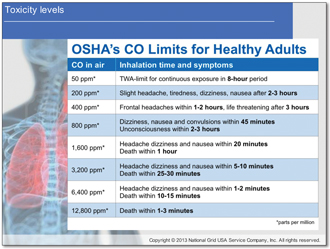Connect with us.

Each year, more than 400 fatalities are attributed to CO poisoning. An additional 20,000 Americans visit emergency rooms and about 4,000 require hospitalization due to CO poisoning each year. But you can protect yourself, your fellow first responders and people in your community by knowing how to prevent CO poisoning. Case-in-point: Undetected carbon monoxide leak sickens first respondersThree firefighters and three paramedics responding to a medical call at an apartment complex arrived to find a man unconscious in a bathroom. As these first responders were tending to the victim they experienced dizziness and nausea. They proceeded to evacuate the building. Subsequently, the firefighters, paramedics, two residents and the original victim were taken to the hospital and treated for carbon monoxide poisoning. A later investigation revealed a carbon monoxide leak from damaged heating equipment. Train to respond safely to carbon monoxide incidentsThe National Grid First Responder Utility Safety Training Program is an e-learning program that provides emergency response personnel with a solid understanding of utility hazards. For example, Module 3 of National Grid’s online Natural Gas Safety Training Certification Program, entitled Carbon Monoxide Poisoning, addresses CO characteristics, toxicity levels, poisoning symptoms, sources, detection and more. Through this training you will learn the knowledge, skills and technical ability required to recognize, respond and prevent carbon monoxide poisoning.
Call Before You DigRemind your colleagues, friends and the public to call your underground utility locator service toll-free at 811 well in advance of digging or moving the earth in any way. They will arrange to mark underground natural gas pipelines, underground electric power lines and other buried utilities so that everyone can work safely. Keep yourself, your team and the public safe. Register today and complete your utility safety training. Visit firstresponder.ngridsafety.com.
|
||||||||||||||||||||||||||||||||||||||||||


